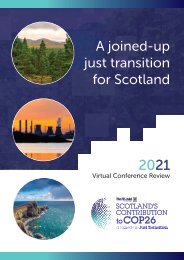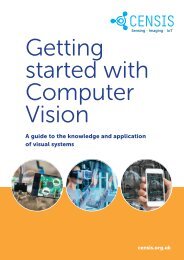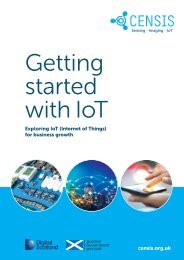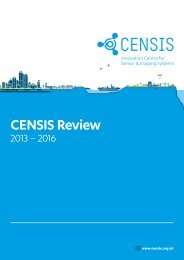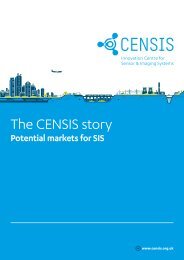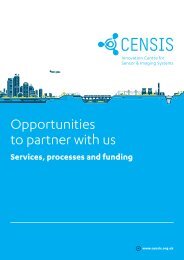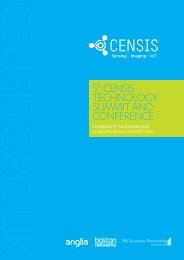CENSIS white paper: Intellectual Property in Business
2023: This CENSIS white paper sets out to make the topic of IP more approachable, less intimidating and more manageable, offering experience-based advice and methods are are designed to help businesses structure their IP- related issues and makes the best of their IP. Covering: The role of IP, IP management during growth, IP strategy for expanding companies and corporates, Business IP Canvas - merging IP with your business model.
2023: This CENSIS white paper sets out to make the topic of IP more approachable, less intimidating and more manageable, offering experience-based advice and methods are are designed to help businesses structure their IP- related issues and makes the best of their IP.
Covering:
The role of IP, IP management during growth, IP strategy for expanding companies and corporates, Business IP Canvas - merging IP with your business model.
Create successful ePaper yourself
Turn your PDF publications into a flip-book with our unique Google optimized e-Paper software.
<strong>Intellectual</strong> <strong>Property</strong> <strong>in</strong> Bus<strong>in</strong>ess: IP basics, IP management, IP strategy<br />
IP Management dur<strong>in</strong>g Growth (cont<strong>in</strong>ued)<br />
13 What to do with your IP<br />
When it comes to decisions relat<strong>in</strong>g to IP strategy,<br />
companies must answer one key question: whether to<br />
pursue a closed, open or semi-open strategy.<br />
John Palfrey gives an <strong>in</strong>terest<strong>in</strong>g perspective on the<br />
use of IP and divides the spectrum of uses <strong>in</strong>to three<br />
categories: full exclusion (closed), limited exclusion<br />
(semi-open) and unlimited exclusion (open).<br />
Full exclusion<br />
You decide to exclude everyone else from us<strong>in</strong>g<br />
some or all of your <strong>in</strong>tellectual property and exploit it<br />
yourself to the greatest extent allowable under law. This<br />
approach corresponds with a common understand<strong>in</strong>g<br />
of <strong>in</strong>tellectual property as ‘a sword and a shield. 33<br />
In this model, a company actively asserts (enforces) IP<br />
rights aga<strong>in</strong>st third parties. In many cases, the process<br />
beg<strong>in</strong>s with a ‘cease and desist’ letter sent to the<br />
party allegedly <strong>in</strong>fr<strong>in</strong>g<strong>in</strong>g the IP rights and ends with a<br />
licens<strong>in</strong>g agreement (settlement) to allow the <strong>in</strong>fr<strong>in</strong>g<strong>in</strong>g<br />
party to cont<strong>in</strong>ue the use of IP rights under specific<br />
conditions and for remuneration (licence fee, royalty). In<br />
this way, a company creates a revenue stream.<br />
However, the reaction of the third party may be<br />
less amicable and it may cont<strong>in</strong>ue us<strong>in</strong>g the IP<br />
rights without authorisation. The party may run its<br />
own due diligence to assess the credibility of the<br />
<strong>in</strong>fr<strong>in</strong>gement claims, as well as ignor<strong>in</strong>g the letter and<br />
any other communication. This forces the company<br />
to consider legal steps, <strong>in</strong>clud<strong>in</strong>g a lawsuit. The less<br />
amicable approach of the third party may shift to a<br />
confrontational one, which will lead to a counterclaim<br />
and an attempt to <strong>in</strong>validate the IP rights of the<br />
company. As Palfrey expla<strong>in</strong>s, this would be the<br />
shield<strong>in</strong>g role of the IP. 34 Despite the obvious tension<br />
<strong>in</strong> such a scenario, it may end with a settlement<br />
agreement that would <strong>in</strong>clude a cross-licence.<br />
Palfrey <strong>in</strong>dicates one strong limitation of this approach:<br />
it does not work aga<strong>in</strong>st big technology breakthroughs<br />
and radically better solutions. He also states,<br />
‘That particular battle has to be won <strong>in</strong> the research and<br />
development labs, not <strong>in</strong> the courtroom.’ 35<br />
The lawsuit path is anyth<strong>in</strong>g but easy (and cheap). In<br />
addition, diverse studies have revealed the risks relat<strong>in</strong>g<br />
to patent disputes and demonstrated that patent<br />
owners (pla<strong>in</strong>tiffs) walk on th<strong>in</strong> ice:<br />
• Janicke and Ren <strong>in</strong> their research from 2005 found<br />
that about 25% of the analysed 262 dispositive<br />
cases 36 <strong>in</strong> 2002-2004 were won by the patent<br />
owner and the other 75% by the accused <strong>in</strong>fr<strong>in</strong>ger. 37<br />
• An analysis of 6,992 post-grant reviews at PTAB<br />
(USPTO) 38 of patents filed between 16 September<br />
2012 and 8 June 2017 revealed rather shock<strong>in</strong>g<br />
numbers: only 4% of petitions ended with all claims<br />
found patentable. A narrower analysis of 1,556<br />
petitions that had reached f<strong>in</strong>al written decisions,<br />
demonstrated that 69% of petitions had all claims<br />
<strong>in</strong>validated. 39<br />
• A quarterly report of the PTAB from September 2020<br />
revealed that out of 3,105 patents that had been<br />
subject to a PTAB F<strong>in</strong>al Written Decision, 2,612 of them<br />
had been determ<strong>in</strong>ed to be ‘Unpatentable/Cancelled’. 40<br />
• Another <strong>in</strong>terest<strong>in</strong>g perspective was provided <strong>in</strong> a<br />
study by Henkel and Zischka, who concluded that<br />
around 80% of all active German patents are latently<br />
<strong>in</strong>valid, either fully or partially. 41<br />
This data presents a real concern that should be<br />
<strong>in</strong>cluded <strong>in</strong> the risk-benefit assessment before<br />
launch<strong>in</strong>g any patent enforcement campaign: a patent<br />
owner may not only lose the <strong>in</strong>fr<strong>in</strong>gement dispute but<br />
also patents <strong>in</strong>volved <strong>in</strong> litigation.<br />
Take-home message: Assert<strong>in</strong>g your IP portfolio may<br />
be the only option to stop competitors from us<strong>in</strong>g<br />
or copy<strong>in</strong>g your solution and make them pay for<br />
the <strong>in</strong>fr<strong>in</strong>g<strong>in</strong>g use. However, the decision must be<br />
thoroughly analysed <strong>in</strong> consultation with your patent/<br />
IP attorney before any actions are taken.<br />
33<br />
Palfrey (n 5) 101.<br />
34<br />
Ibid 102.<br />
35<br />
Ibid 104.<br />
36<br />
‘A case <strong>in</strong> which, as it leaves the Federal Circuit, at least one claim of one patent is f<strong>in</strong>ally adjudicated to have been <strong>in</strong>fr<strong>in</strong>ged and not <strong>in</strong>valid or unenforceable<br />
(i.e., a w<strong>in</strong> for the patent owner), or <strong>in</strong> which it has been f<strong>in</strong>ally determ<strong>in</strong>ed that no claim has these characteristics (a w<strong>in</strong> for the accused <strong>in</strong>fr<strong>in</strong>ger).’ Paul M. Janicke<br />
and LiLan Ren, ‘Who W<strong>in</strong>s Patent Infr<strong>in</strong>gement Cases?’ (34 AIPLA Quarterly Journal 1, 1, 2006) 4 <br />
accessed 2 December 2022.<br />
37<br />
Ibid 5.<br />
38<br />
Patent Trial and Appeal Board of the US Patent and Trademark Office.<br />
39<br />
Josh Malone, ‘Assess<strong>in</strong>g PTAB Invalidity Rates’ (IP Watchgod, updated 24 June 2021)<br />
accessed 2 December 2022.<br />
40<br />
Ibid.<br />
41<br />
Joachim Henkel and Hans Zischka, ‘Why most patents are <strong>in</strong>valid – Extent, reasons, and potential remedies of patent <strong>in</strong>validity’ (Draft, 24 March 2015), 3<br />
accessed 2 December 2022.<br />
29






